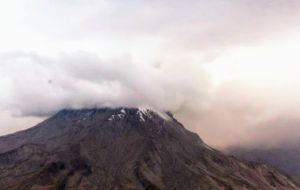MercoPress. South Atlantic News Agency
Volcano eruption leads to state of emergency, evacuations in southern Peru
 The Ubinas volcano, the most active in Peru, had not erupted since 2017.
The Ubinas volcano, the most active in Peru, had not erupted since 2017. Peru's government has declared a state of emergency and carried out numerous evacuations in the areas hit in one way or another by the Ubinas volcano's eruptive process which has affected around 30,000 people in the south of the country, mainly due to the dispersion of ashes, authorities reported Sunday.
According to the National Emergency Operations Center (COEN), 617 schools and 20 health centres in the areas of Moquegua, Arequipa, Tacna and Puno were covered in ashes, having an impact on the lives of 29,700 people, most of whom -some 19,000 people- were in the region of Puno, bordering Bolivia, followed by Moquegua with more than 9,200, Arequipa with 1,257 and Tacna, on the border with Chile, with 141 inhabitants in the province of Candarave.
The volcanic activity peaked Thursday when a column of ash of about 5,000 metres high dispersed in several regions of the south of the country, even reaching places in neighbouring Bolivia.
Volcanological scholar Jersy Mariño of the Mining and Metallurgical Geological Institute (Ingemmet), said that “for now, it is a moderate eruption that has reached almost 5 kilometers high,” which is being monitored every day. There are eight volcanoes in southern Peru, but the Ubinas is particularly active with eruptions “every 5 or 6 years, Mariño explained.
Peru is located in the so-called ”Pacific Ring of Fire,” an area with a high incidence of earthquakes and volcanic activity.
The explosions and the emission of gases from the Ubinas volcano in Moquegua, 1,250 km south of Lima and 5,672 metres above sea level, led to the declaration of a state of emergency in 12 districts in southern Peru and the evacuation of nearby towns, the government announced on Saturday, to allow for immediate response measures to be carried out and the rehabilitation of the villages located around the volcano.
The evacuation was arranged after the Geophysical Institute of Peru (IGP) warned that “the Ubinas volcano continues in eruptive process” and recommended to “raise the level of volcanic alert from yellow to orange.”
Luisa Macedo of the IGP told reporters that “this is the strongest activity recorded in the last two eruptive cycles of this volcano, reaching a level III when the previous ones between 2006 and 2017 did not surpass level II,” told the press.
The eruption column reached a height of about six kilometres above the crater of the volcano, while the winds have directed huge clouds of ash and toxic gases towards the Bolivian border.
Peruvian Civil Defense head Jorge Chávez explained that about 1,000 of the 9,249 people living near the volcano -and whose crops and water supply had been affected- were evacuated.
The Ubinas volcano, the most active in Peru, had not erupted since 2017. In April 2014, the government maintained an emergency for 60 days for the towns surrounding the volcano, after checking that the massif had begun to eject lava fragments.
Peru's National Meteorology and Hydrology Service (Senamhi) immediately foresaw ash particles would reach the Bolivian departments of La Paz, Cochabamba, Santa Cruz and part of the department of Chuquisaca as “one more cloud in the sky with darker coloration,” which was evebtually corroborated to the media by people from Cochabamba. Thunderstorms have been forecast for Monday in the area.




Top Comments
Disclaimer & comment rulesCommenting for this story is now closed.
If you have a Facebook account, become a fan and comment on our Facebook Page!